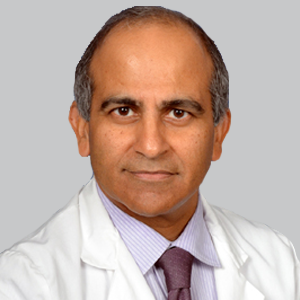Commentary
Article
NeuroVoices: Sandeep Rana, MD, on Progress in Adult-Onset Spinal Muscular Atrophy
Author(s):
The director of the ALS Clinic at Allegheny Health Network provided perspective on the advancements in the treatment and management of adult-onset spinal muscular atrophy.
Sandeep Rana, MD

There are 5 types of spinal muscular atrophy (SMA) caused by a mutation or deficit of a specific gene known as survival motor neuron 1 (SMN1) on chromosome 5q. In less than 5% of cases, SMA is caused by mutations of other genes. Unlike other forms of the disease, which show up in utero, during infancy, or childhood, SMA type 4 is diagnosed in adulthood and is therefore the mildest of all types. According to the National Institute of Health Genetic and Rare Diseases Information Center, the prevalence of SMA type 4 is around 1 in 300,000.
Patients with SMA type 4 typically receive their diagnosis 20 to 30 years into their lifespan, and are characterized by mild to moderate proximal muscle weakness, fatigue, and tremors. Although their condition may be debilitating at times, it is nothing in comparison to SMA types 0 and 1, which have expected lifespans of less than 6 months and 2 years, respectively. While there is no cure, the introduction of 2 mRNA-splicing therapies—nusinersen (Spinraza; Biogen) and risdiplam (Evrysdi; Genentech)—have changed the way the disease is managed.
To learn more about adult-onset SMA, NeurologyLive® sat down with Sandeep Rana, MD, a neurophysiologist and director of the ALS Clinic at Allegheny Health Network. As part of a new iteration of NeuroVoices, Rana, who also serves as a professor of neurology at Drexel University, discussed the management and treatment of adult-onset SMA, current research in this field, and significant advances made in recent years.
NeurologyLive®: What are some of the earliest signs that an adult may be developing onset SMA?
Sandeep Rana, MD: Typically, adult-onset SMA presents as a gradual and progressively weakening condition, primarily affecting the legs, especially the proximal muscles rather than the distal ones. Patients often complain of difficulty rising from a seated position, climbing stairs, and experiencing frequent falls. This weakness worsens over the years. Numbness and tingling sensations are not commonly reported. As time passes, weakness can extend to the arms, and in some cases, it can impact breathing. In summary, it's characterized by a slowly progressing and aggressive weakness.
For babies with SMA, we're eager to initiate treatment as soon as possible. Is the same true for adults?
It's essential to achieve an early diagnosis even in adult-onset SMA. Many adult patients struggle to find the right clinician with the necessary experience to provide a formal diagnosis. They often consult multiple clinicians without receiving a definitive diagnosis. Therefore, early diagnosis is crucial. The sooner a diagnosis is made, the earlier treatment can begin. There are medications available now, and the earlier treatment commences, the better the results. Finding a specialized center with experience in diagnosing and treating the condition holistically, including medications, physical therapy, and adaptive devices, is essential.
What does treatment and management look like for these patients?
First and foremost, an accurate diagnosis is crucial. Diagnostic tools such as EMG can be very helpful, and molecular genetic testing can confirm the diagnosis by identifying specific gene mutations. Once the diagnosis is confirmed, treatment can begin. For many years, there were no treatment options beyond supportive care, but recently, disease-modifying treatments have become available for adult-onset SMA. Two medications are commonly used: nusinersen, which is administered intrathecally, and risdiplam, which is taken orally. Nusinersen can modify genes and produce the deficient protein, slowing the disease's progression. Risdiplam is taken daily orally. These treatments, combined with adaptive devices, physical therapy, and respiratory support, constitute the holistic approach to managing SMA.
How have management goals for SMA changed over the years?
The management goals for SMA have evolved significantly. With the availability of disease-modifying treatments like nusinersen and risdiplam, there is hope for slowing down the progression of the disease. In the past, patients had to adjust to their progressive deficits, but now, they can maintain their functional abilities and even continue with their professions. This newfound confidence and sense of control over their disease are exciting developments. Additionally, there are improved adaptive devices available for mobility, communication, and respiratory support, greatly enhancing patients' quality of life.
For adult-onset SMA, where has research primarily focused, and where would you like to see increased efforts?
Research for adult-onset SMA has mainly centered around gene-modifying treatments, which have shown promise. There is ongoing work in this area, and hopefully, even better treatment options will emerge in the future. In childhood SMA, there's a method of replacing the mutated gene using viral vectors, but this is currently only available for patients under two years old. It's possible that future breakthroughs could make this option available for adult patients as well. Additionally, there is potential for stem cell treatments to be developed in the coming years. As neurologists, we remain hopeful that ongoing scientific advancements will lead to improved cures for SMA.
Transcript was edited for clarity. Click here for other iterations of NeuroVoices.




